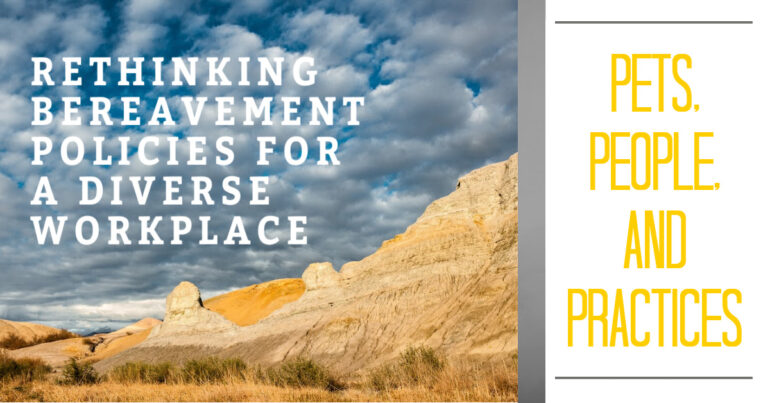
Pets, People, and Practices: Rethinking Bereavement Policies for a Diverse Workplace
By: Destyn Land
One of the most important aspects of my culture is the way we view family. While the term “immediate family” typically includes only parents, children, and siblings, my close family extends beyond these traditional boundaries. For many of us, cousins are like siblings, aunts and uncles are like second sets of parents, and our family doesn’t always fit neatly into biological relationships. This fluid concept of family is vital to understanding the importance of diversity, equity, and inclusion (DEI) policies in the workplace.
If we look closely enough and put on a different lens, we often will discover gaps between policy and practice. Despite organizations having policies that promote diversity, equity, and inclusion, it’s essential to assess their effectiveness in practice. For instance, even if a company has a policy on using inclusive language, it doesn’t necessarily guarantee the eradication of discriminatory language in the workplace. To create a supportive and safe work environment where all employees feel valued, the voices and experiences of marginalized individuals should be genuinely listened to and taken seriously. Action is necessary when employees from marginalized communities share how they’ve been harmed to strengthen the company’s commitment to DEI.
One area where DEI policies often fall short is in bereavement policies. The average bereavement policy gives a certain number of days off for the death of parents, siblings, children, grandparents, grandchild, extended family members, and close friends. However, there are potential gaps in this policy.
Broadening our understanding of family is the first step.
- For many of us, family is not limited to biological relationships. There are many people within the LGBT+ community whose biological family has caused them harm, and now they no longer keep in touch with some of them. They still may have what is often referred to as “chosen family,” individuals who are as close to them as any biological family member. When a bereavement policy defines who an employee’s “close family” is, it erases the fluidity of family that exists for many people. Chosen family members are just as much family as biological family members, and a bereavement policy should reflect that. Additionally, some pet owners consider their pets as family members, and bereavement policies should include them too.
- Have you thought about whether your bereavement policy includes pets? As someone who didn’t grow up with pets, I didn’t initially appreciate how significant losing a pet could be for some people who consider them family members. However, my perspective shifted after my close friend’s dog of 16 years passed away. Listening to their stories, I realized that the dog had been a source of emotional support throughout tough times. Unfortunately, their employer didn’t allow bereavement to leave for pets, which had a negative impact on both their mental health and job performance. It’s essential to recognize that pets can hold a significant place in employees’ lives and to offer appropriate support during times of mourning.
Another vital aspect of bereavement policies is recognizing that mourning practices look different across cultures.
- When someone dies, the grieving process can vary greatly across cultures. For some individualistic societies, mourning is prepping for a service or memorial of some kind, and then after the service life resumes as normal. However, for some cultures, mourning can extend far beyond this. For example, when my partner’s family member passed away, in their culture every family member spends time at the eldest member of the family’s home from the day of death, until the day of the funeral. My partner and her family spent the night there close to every night, sitting together, sharing memories, cooking food, and grieving as a community. While there is no one-size-fits-all solution for dealing with loss, bereavement policies need to respect the fact that different cultures have diverse customs, rituals, and practices surrounding death.
You may be questioning, is this too open-ended, and too easy for people to misuse or abuse? Despite the seeming disadvantage associated with such policies, it’s essential to consider cultural nuances where personal needs differ from one another. The goal of equity is not fairness, but rather it’s about having what every person needs.
While there is always room for someone to game the system, constant lies about the death of a family member or friend to get time off point to a much deeper issue with the company culture that needs addressing. Instead, writing the policy in a way that accommodates some level of nuance while still setting guidelines is the way to go. For instance, the policy could include a guideline indicating the number of days available for bereavement leave. The policy can also acknowledge that people process grief differently and that cultural backgrounds play a role in how people react to grief. The policy may state, “We recognize that grief impacts people differently, and different cultures have different norms for grieving. If, for any reason, an employee needs extended bereavement leave beyond the given number of days, they can contact Human Resources or their direct supervisor.”
The goal should be flexibility rather than rigidity. The work of Diversity, Equity, and Inclusion demands us to think and act beyond our comfort zones in specific situations, making it crucial to keep questioning and brainstorming new solutions. Being risk-averse is okay, but it’s equally important to embrace possibilities for making workplaces more supportive for everyone.
While there may be many concerns about bereavement policies, ensuring employees can grieve and come back to work ready to be productive is essential for a company’s health and longevity. Writing policies in ways that accommodate nuances while reinforcing guidelines is a right step in the goal of creating a workplace where everyone has what they need to thrive.

